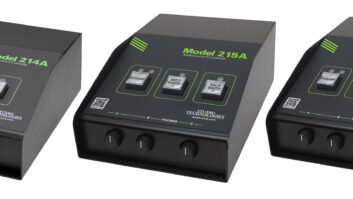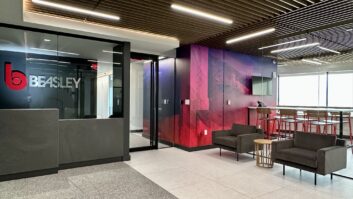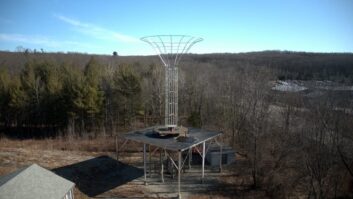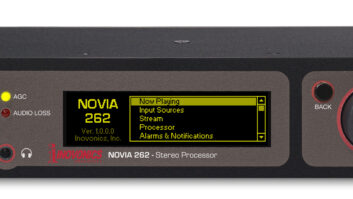
KPBS(FM) control rooms, like this one shown after renovation, combine 1990s-era studio furniture with new Harris consoles. Moving a high-powered FM transmitter site can be enough of a project to consume an engineering team’s entire year. So can rebuilding an entire studio complex.
For the team at public broadcaster KPBS(FM) in San Diego, this past year brought both: a major upgrade to the studio core, and a new transmitter site with better coverage of their target audience.
When KPBS moved in 1994 into its current studio home, the Copley Telecommunications Center on the campus of licensee San Diego State University, it didn’t have to look far to find the consoles it needed for its radio studios.
Pacific Recorders & Engineering was based just up the 5 Freeway in Carlsbad. Chairman Jack Williams, seeking a local facility where he could show clients the company’s gear in action, donated boards for a studio complex that came to include a main air studio, a performance studio, a talk studio and control room, and a production suite.
Other equipment came over from the cramped studios KPBS radio and TV had occupied elsewhere on the SDSU campus; and some studio furniture was donated by local commercial broadcasters.
The result was a neat line of studios arrayed along both sides of a hallway on the first floor of the KPBS building, and it served the station well for almost two decades.
Help from PTFP
By the early 21st century, KPBS Director of Engineering and IT Leon Messenie says a change was needed.

One remaining studio features the original Pacific Recorders equipment from the station’s 1990s-era buildout. “The boards were getting harder and harder to keep running.” And in a facility that was spreading out, there was no good way to move audio around the plant. “We didn’t have a routing switcher. Just distribution amps and selectors.”
Messenie says the goal was to bring KPBS’ studios into the digital world on a tight budget of $225,000. For most of the studios, including the main on-air studio, that meant replacing the old PR&E consoles but leaving most of the furniture and outboard gear intact.
(There was another big reason to keep the furniture in place: Those 1990s-era studios were large spaces even when they were built, and Messenie says the heavy wood-and-formica studio furniture, complete with turrets hanging over the operator positions, helped to keep the rooms from feeling too cavernous.)
Working through PTFP, the now-defunct Public Telecommunications Facilities Program, KPBS secured a matching grant to cover half the cost of replacing the consoles in three of its studios.
While the process required KPBS to use the lowest bidder, Messenie says he was pleased with the outcome. That bid came from Harris, which had acquired PR&E along the way.
“There still is a lot of good blood between us, and the PR&E engineering team is still just up the road in Carlsbad,” Messenie says.
The three rebuilt studios all received the same new 20-channel Harris RMXdigital consoles, as well as new AirTools 2X dual-channel voice processors from BSW. Behind the scenes, KPBS also installed a new Harris routing and distribution network.
That network proved to be a vital part of the station’s reconstruction, when most of the radio studio operations were moved upstairs to a tiny temporary studio built in a room just off the KPBS newsroom. (Unlike most public broadcasters, KPBS produces daily news content for both radio and television, and it had just finished building out its new open-plan newsroom before embarking on the radio project downstairs.)
With a tight deadline to complete the project to meet the terms of the grant, Messenie and his team had to move quickly. Following the buildout of the temporary studio upstairs in January 2012, KPBS all but vacated its downstairs studios, giving the Harris/PR&E team “the run of the place” as they worked to get the new studios up and running by late spring.
On to Soledad
No sooner had the KPBS radio staff returned to its regular studios and their new equipment than Messenie and Maintenance Manager Scott Stinson were plunged into their second big project of the year.
For decades, KPBS radio and TV had shared a transmitter site atop Mount San Miguel, at nearly 2,500 feet above sea level and some 10 miles southeast of downtown San Diego.

The eight-bay ‘Quadzilla’ antenna is mounted at lower right on the KFMB(TV) tower on Mount Soledad. Above it are main and backup antennas for KFMB(TV) and the four-bay backup antenna that kept the ‘Quadzilla’ stations on the air during the antenna replacement. That location was a mixed blessing for KPBS: With just 2,700 watts effective radiated power at 1,800 feet above average terrain, the station enjoyed superior coverage of downtown and the eastern San Diego suburbs, as well as a healthy reach over the Mexican border just a few miles to the south. Much of the market’s growth, however, had moved instead to the north along the coast; and the rugged coastal terrain blocked KPBS from providing a clean signal into affluent areas such as La Jolla and Del Mar.
From the time Messenie joined KPBS in 1981, he says plans were afoot to move the Class B 89.5 MHz signal to Mount Soledad, a lower peak (just 765 feet above sea level) that had the advantage of a clean line of sight up and down most of the coast. Over the years, many of San Diego’s FM stations had migrated to Soledad, but KPBS had long been thwarted from joining them because of spacing issues to an analog Channel 6 signal, XETV in adjacent Tijuana, Mexico.
The shift to digital TV finally opened up a new window for KPBS to move. Another San Diego noncommercial station that had fought against XETV for a power upgrade, KSDS(FM) on 88.3, won a ruling from the FCC that the Mexican Channel 6 operation no longer needed to be protected on U.S. soil, and Messenie says once KSDS had permission for its upgrade, “the floodgates opened” at the FCC and KPBS was clear to relocate.
While KPBS had earlier investigated the possibility of building its own tower on Mount Soledad, the ensuing years had brought cooperation with one of the mountain’s oldest tower owners, Midwest Television’s KFMB(TV).
In 2000, KFMB constructed a new master FM facility on its 285-foot Soledad tower, initially with the intention of having KPBS as one of the tenants. When KPBS found itself unable to move, KFMB instead found other commercial tenants higher on the dial, building its eight-bay Dielectric “Quadzilla” master antenna to cover a range of frequencies from 94.9 to 100.7.
For KPBS to join the “Quadzilla” family meant a full antenna replacement, and the public broadcaster shouldered the cost of having Dielectric build a second version of the mammoth antenna that could handle frequencies from KPBS’ 89.5 up to KFMB(FM)’s 100.7.
Before contractors from Wireless Infrastructure could take down the original “Quadzilla” and mounted its replacement, KPBS had to provide a temporary backup antenna as well, moving KFMB(FM) and its two tenants, Lincoln Financial Media’s KBZT(FM) and KIFM, to the four-bay auxiliary during construction.
The KPBS move meant much higher power than the station had used on Mount San Miguel: Instead of a 2.7 kW ERP from its old site, KPBS now runs 25.7 kW ERP from Soledad. That meant a new transmitter to make 9.4 kW of output power, and KPBS turned to Nautel for a new NV20 for the new site. The old Harris Z-Series transmitter on Miguel remains in place; since KPBS(TV) still uses the site, the FM station is keeping an auxiliary facility there.
A Moseley 950 MHz Starlink STL connects the KPBS studios to the new Soledad site, carrying audio and data for both KPBS’ main audio service and its HD2/HD3 subchannels. From Soledad, KPBS is now running HD Radio at –14 dBc. Messenie says the higher digital power level has helped HD coverage, though it has required some cooperation with a fellow public broadcaster to the north, adjacent-channel KPCC (89.3) in Pasadena, to alleviate some interference into KPCC’s coverage of Orange County.
Since the new Soledad site went on the air Oct. 1, completing the $1.2 million relocation project, Messenie says it’s performed just as expected.
“From Mission Valley going north, there has been a great improvement,” he says. While the new site has improved coverage along the coast, it’s still blocked by rugged terrain from reaching some areas, including the 78 Freeway corridor heading inland from San Diego’s northernmost suburbs.
The East County area that used to receive the strongest signals from Mount San Miguel no longer hears KPBS as well as it once did, and Messenie says he’s hoping to find a way to restore stronger service there, perhaps by repurposing a small translator on 89.1 that KPBS had been using to fill a coverage gap in La Jolla that’s now blanketed by the new Soledad signal.
With new studios and a new transmitter now in place, the next project on the agenda will be upstairs, in the space where the temporary radio studios were built last year. KPBS hopes to build out that room in a more permanent fashion as an additional radio news studio, allowing its newspeople to do more of their studio work right next to their office space.
Scott Fybush is a longtime contributor. He wrote in the Jan. 16 issue about the Santa Catalina site that KBRT(AM) is leaving.












